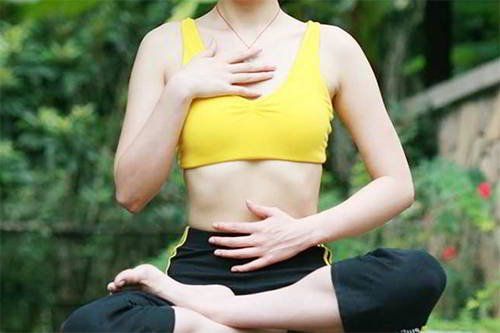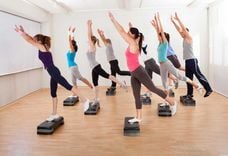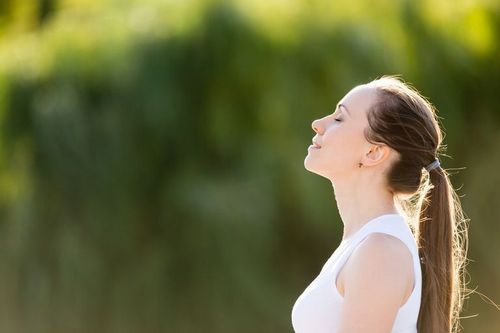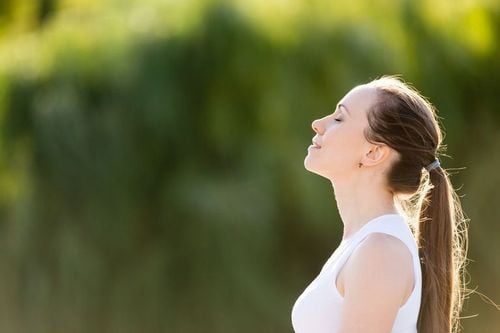This is an automatically translated article.
Take a deep breath and exhale. You will feel the difference in your body. Breathing is a powerful tool to relieve stress and make you less anxious. Here are 10 breathing techniques you need to know to make a big difference in stress management and make them part of your regular routine.1. Integrate breathing exercises into your life
Taking a little time out of your day to focus on breathing exercises that help reduce stress, anxiety, or improve your lung function is certainly not impossible. Here are a few suggestions to help you make daily breathing a habit:Start with just 5 minutes a day and increase your time as the exercise becomes easier and more comfortable. If 5 minutes feels too long, start with just 2 minutes. Practice several times a day. Schedule a scheduled time or practice conscious breathing when you feel the need.
2. 10 breathing techniques you need to know
2.1. pursed lips
This simple breathing technique helps you slow down your breathing rate by trying to control each breath on your own accord. You can breathe pursed lips at any time, which is especially helpful during activities like bending over, lifting heavy objects, or climbing stairs.Practice this breathing 4 to 5 times per day as you begin to learn how to breathe properly.
* Exercise :
Relax your neck and shoulders. Close your mouth and inhale slowly through your nose for 2 counts. Pinch your lips as if you were whistling Exhale slowly by blowing air through your pursed lips for a count of 4.
2.2. Diaphragm breathing
Breathing exercises help you use your diaphragm properly. Do this breathing exercise when you are most resting and feeling most relaxed. It may feel tiring at first, but over time the technique will become easier and you will feel more natural.Practice diaphragmatic breathing for 5 to 10 minutes, 3 to 4 times per day.
* Execution :
Lie on your back, knees slightly bent and head pillowed. You can place a pillow under your knees to support you. Place one hand on your upper chest and one below your rib cage, so that you feel the movement of your diaphragm. Slowly inhale through your nose and feel your belly pressing against your hands. Keep your other hand as still as possible. Exhale by pursed lips as you squeeze your abs, keeping your upper arms completely still. You can put a book on your stomach to make the exercise more difficult. After learning how to do belly breathing while lying down, you can increase the difficulty by trying it out while sitting in a chair. You can then practice this technique while doing your daily activities.

Thở bằng cơ hoành khi bạn nghỉ ngơi và cảm thấy thư giãn nhất
2.3. Breath focus technique
This deep breathing technique uses images or phrases or focused words.You can choose a word that makes you smile, feel comfortable. For example Peace, Relax... Or any other word that works for you so you can focus and repeat during your practice.
When building a method of focusing on the breath, you can start with a 10-minute exercise. Gradually increase the duration until you can sustain the exercise for at least 20 minutes.
* Do:
Sit or lie in a comfortable, cool place Try not to change the way you breathe. Alternate between breathing normally and taking a few deep breaths. Notice any difference between normal breathing and deep breathing like how your belly expands on a deep inhale. Notice how shallow versus deep breathing feels. Practice deep breathing for a few minutes. Place one hand below your navel, keep your belly relaxed, and notice how it rises with each inhale and lowers with each exhale. Exhale after each exhale. Start practicing focusing on your breath by combining deep breathing with an image and a word or phrase like the one above to help you relax. You can imagine that the air you breathe in will bring waves of peace and calm throughout your body. You can meditate: "Calm and relax". Imagine that the air you exhale washes away stress and anxiety. You can say to yourself, "Let go of stress and anxiety."
2.4. Lion's breath
This is an energizing yoga breathing exercise that is said to help relieve tension in your chest and facial muscles.* Perform
Get into a comfortable sitting position. You can sit on your heels or cross your legs. Press your palms to your knees with outstretched fingers. Take a deep breath in through your nose and open your eyes wide. At the same time, open your mouth wide and stick out your tongue, bringing the nipple down towards your chin. Contract the muscles at the front of your throat as you exhale through your mouth by making a long "ha" sound. You can direct your gaze to the middle of your eyebrows or the tip of your nose. Do this breath 2-3 times.
2.5. Breathe through the nose alternately
Nose breathing (also known as nadi shodhana pranayama in Sanskrit) is a way to relax and has been shown to boost cardiovascular function and lower your heart rate.Nadi shodhana pranayama is best practiced on an empty stomach. Avoid exercising when you are feeling tired or have obstructive pulmonary disease (COPD). Keep your breathing even and smooth throughout the exercise.
* Exercise
Choose a comfortable sitting position. Lift your right hand up towards your nose, press your index and middle fingers down into your palm, leaving the other fingers extended. After exhaling, use your right thumb to gently close your right nostril. Inhale through the left nostril and then close the left nostril with the right little finger and ring finger. Release your thumb and exhale through your right nostril. Inhale through your right nostril and then close this nostril. Release your fingers to open the left nostril and exhale from the side. Continue this breathing pattern for up to 5 minutes.
2.6. Breathe regularly
Even breathing (also known as sama vritti in Sanskrit). This breathing technique focuses on inhaling and exhaling at the same length. Making your breathing smooth and steady brings balance and a state of calm.You should find the right breath length to maintain it throughout the exercise. Usually 3 - 5 counts. Once you get used to regular breathing while sitting, you can do it while you do yoga or other daily activities.
* Exercise
Choose a comfortable sitting position. Breathe in and out through your nose. Count in each inhalation and exhalation to make sure they are evenly spaced. Alternatively, you can choose a short word or phrase to repeat during each inhalation and exhalation. You can add a little pause or hold after each inhale and exhale if you feel comfortable. (Normal breathing includes a natural pause.) Continue this breathing practice for at least 5 minutes.
2.7. Sound or rhythm of coherent breathing
Combined breathing, also known as resonance breathing, is when you breathe at a rate of 5 regular and full breaths per minute. You can use inhalation and exhalation counting 5 times to achieve the right speed.Breathing at this rate maximizes your heart rate variability (HRV), reduces stress and, according to a 2017 study, can reduce symptoms of depression when combined with this breathing movement. Iyengar yoga.
* Execution
Inhale for a count of 5 Exhale for a count of 5 Continue this breathing pattern for at least a few minutes.

Tập hít thở đúng cách giảm bớt căng thẳng và tăng cường sức khỏe
2.8. Sitali Breath
This yoga breathing exercise will help you lower your body temperature and relax your mind. Exhale but do not force, because you are inhaling through your mouth while breathing Sitali, you should choose a place of practice that is free of any allergens that affect you and has air pollution.* Exercise
Choose a comfortable sitting position. Stick your tongue out and roll it back to pull the outer edges together. If your tongue can't do this, you can purse your lips. Inhale through the mouth. Exhale through the nose. Continue breathing like this for up to 5 minutes.
2.9. Deep breath
Deep breathing helps you to reduce shortness of breath by preventing air from getting trapped in your lungs and helping you to breathe cleaner air. It also helps you feel more relaxed and focused.* Perform
While standing or sitting, bring your elbows back slightly to expand your chest. Breathe deeply through your nose. Hold your breath for a count of 5. Then slowly exhale by exhaling through your nose.
2.10. Breath is humming
This yoga breathing method helps to create instant calm and especially creates a feeling of lightness around your forehead. Some people use bee breath to relieve frustration, anxiety, and anger. You should do it in a quiet place or where you can make a humming sound without disturbing anyone.* Exercise
Choose a comfortable sitting position. Close your eyes and relax your face. Place your first fingers on the auricle cartilage that covers part of your ear canal. Inhale and as you exhale, gently press your fingers into the cartilage. Close your mouth, then make a loud humming sound. Continue until you feel comfortable. The above are most of the breathing exercises you should apply as soon as possible. Try to spend a little time experimenting with different breathing techniques, and set aside a certain time of the day or at least a few times a week to do these breathing exercises. You can consult your doctor or yoga teachers who specialize in breathing exercises for detailed advice for your condition. Stop exercising if you feel uncomfortable or agitated.
Please follow the website ( www.vinmec.com ) for more information on health care instructions, which we will update regularly.
Please dial HOTLINE for more information or register for an appointment HERE. Download MyVinmec app to make appointments faster and to manage your bookings easily.
Reference source: healthline.com












